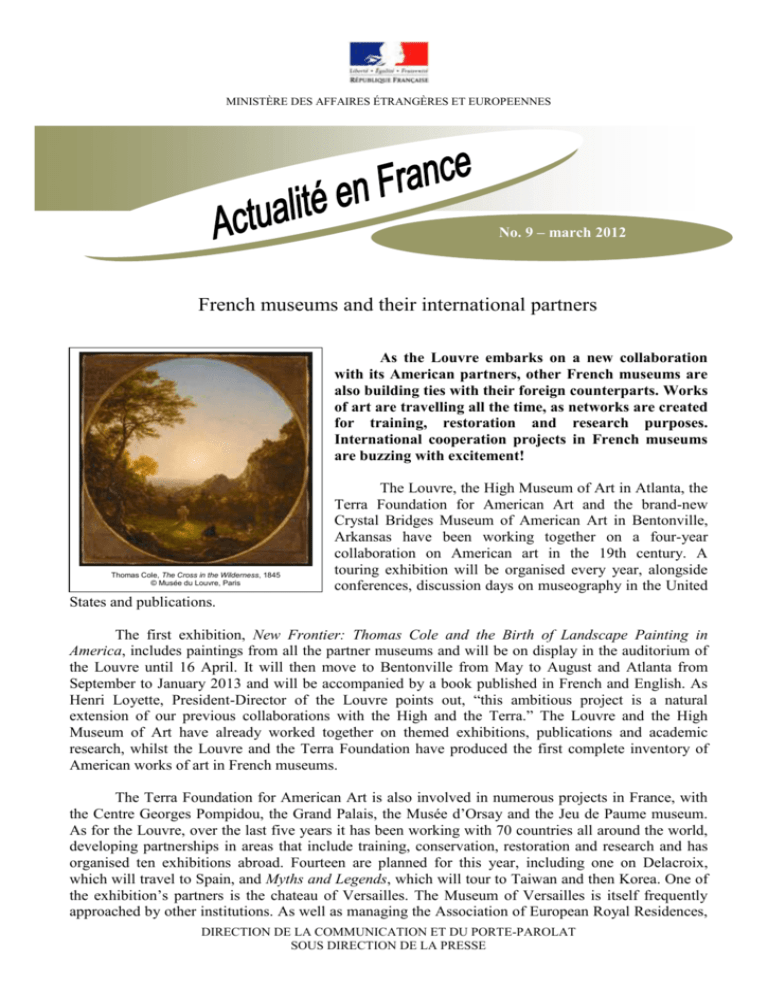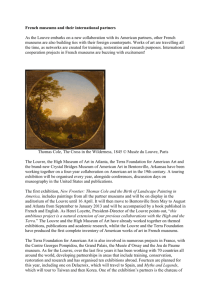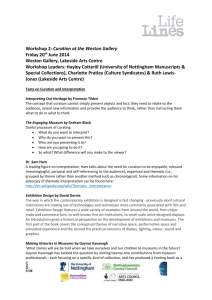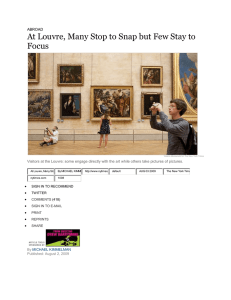MINISTÈRE DES AFFAIRES ÉTRANGÈRES ET EUROPEENNES As
advertisement

MINISTÈRE DES AFFAIRES ÉTRANGÈRES ET EUROPEENNES No. 9 – march 2012 French museums and their international partners As the Louvre embarks on a new collaboration with its American partners, other French museums are also building ties with their foreign counterparts. Works of art are travelling all the time, as networks are created for training, restoration and research purposes. International cooperation projects in French museums are buzzing with excitement! Thomas Cole, The Cross in the Wilderness, 1845 © Musée du Louvre, Paris The Louvre, the High Museum of Art in Atlanta, the Terra Foundation for American Art and the brand-new Crystal Bridges Museum of American Art in Bentonville, Arkansas have been working together on a four-year collaboration on American art in the 19th century. A touring exhibition will be organised every year, alongside conferences, discussion days on museography in the United States and publications. The first exhibition, New Frontier: Thomas Cole and the Birth of Landscape Painting in America, includes paintings from all the partner museums and will be on display in the auditorium of the Louvre until 16 April. It will then move to Bentonville from May to August and Atlanta from September to January 2013 and will be accompanied by a book published in French and English. As Henri Loyette, President-Director of the Louvre points out, “this ambitious project is a natural extension of our previous collaborations with the High and the Terra.” The Louvre and the High Museum of Art have already worked together on themed exhibitions, publications and academic research, whilst the Louvre and the Terra Foundation have produced the first complete inventory of American works of art in French museums. The Terra Foundation for American Art is also involved in numerous projects in France, with the Centre Georges Pompidou, the Grand Palais, the Musée d’Orsay and the Jeu de Paume museum. As for the Louvre, over the last five years it has been working with 70 countries all around the world, developing partnerships in areas that include training, conservation, restoration and research and has organised ten exhibitions abroad. Fourteen are planned for this year, including one on Delacroix, which will travel to Spain, and Myths and Legends, which will tour to Taiwan and then Korea. One of the exhibition’s partners is the chateau of Versailles. The Museum of Versailles is itself frequently approached by other institutions. As well as managing the Association of European Royal Residences, DIRECTION DE LA COMMUNICATION ET DU PORTE-PAROLAT SOUS DIRECTION DE LA PRESSE MINISTÈRE DES AFFAIRES ÉTRANGÈRES ET EUROPEENNES it delivers extremely popular turnkey exhibitions, such as the one on Napoleon in Japan and the one on Louis XIV in China. Versailles is also associated with the Louvre in Abu Dhabi, a project involving numerous institutions including the Musée du Quai Branly. Unsurprisingly, Paris’s ethnological museum works on collaborative projects in a wide range of areas, including building and development, inventories of collections and database creation with Morocco, Micronesia, Mongolia, Peru, Vietnam and others. A study has been launched with the British Museum on the textiles of the Andes and a research project has been started on photographs of Australian aborigines with the Centre for Indigenous Australian Studies at Monash University, the Museum of Archaeology and Anthropology at the University of Cambridge and the Museum of Ethnology in Leiden. This year, the Quai Branly and the National Museum of China are organising two exhibitions. The French museum has embarked on a special collaboration with the National Museum of Mali, including educational activities and publications of academic research. It is also taking part in the “Museums for Development” programme, which involves 26 African museums... and so it goes on! Regional museums are also buzzing with excitement, particularly, at the moment, those in Marseille, the 2013 European Capital of Culture. Amongst other things, the city’s museums are working with the Musée Granet in Aix-en-Provence to prepare an exhibition on the “Studio of the South” entitled Le Grand Atelier du Midi, which will feature works from both the United States and Russia. In the meantime, they have been busy co-producing exhibitions with foreign partners such as Orientialism in Europe with the Royal Museums of Fine Arts in Belgium, and last year, an exhibition on the Austrian artist Hundertwasser, with the Hundertwasser Foundation in Vienna. They have also loaned works for the Caravaggio exhibition to be held this summer in Toulouse and Montpellier before it heads for Los Angeles. The museums in all three of these southern French cities are part of the Frame association, whose other members include institutions in Bordeaux, Dijon, Grenoble, Lille, Lyon, Rennes, Rouen, Strasbourg and the United States (26 in all), which work together on artistic and educational projects. The trend towards internationalisation is growing all the time, according to Franck Lacaille, the curator responsible for loans management at Versailles: “All the world’s major museums are in contact with each other, but we are now seeing the same in small museums in Europe, the United States and Canada, as well as a diversification towards Korea, China and South America. Collections now travel far and wide as the number of exhibitions soars.” A globalisation of museums which can only benefit their primary audience: the public! Sylvie Thomas DIRECTION DE LA COMMUNICATION ET DU PORTE-PAROLAT SOUS DIRECTION DE LA PRESSE





